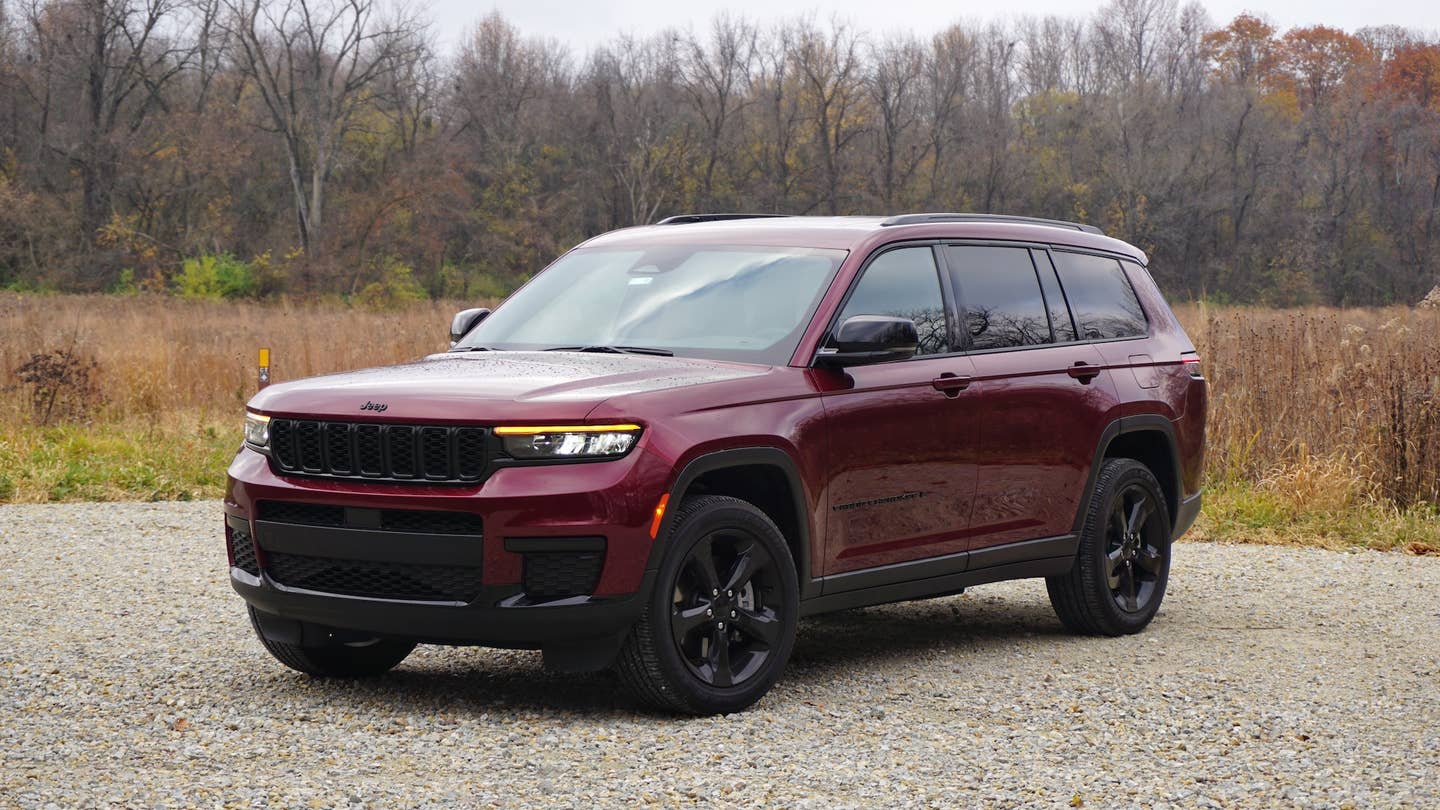The Grand Cherokee’s biggest plus is its family-friendly cabin, but it lacks both the substance and pizzazz of its competitors.

Long before every domestic and foreign automaker offered a rugged, family-friendly SUV, the Jeep Grand Cherokee ruled the roost. Whether you bought one to drive around your Montana ranch or take the family on road trips along the California coast, the capable and refined Jeep always seemed to be the right choice.
The Grand Cherokee first went on sale back in 1992, when the automotive landscape couldn’t be any more different than it is today. Dealer lots are now jam-packed with fresh models pushing similar—if not identical—agendas as the Grand Cherokee, all while the beloved nameplate is still powered by an engine well into its teenage years. Thirty-two years on, the Grand Cherokee wants to tout the same core values: capability, practicality, and that pinch of American Badass that comes with nearly every Jeep product. But can it still pull it off?
| 2023 Jeep Grand Cherokee L Altitude 4×4 Specs | |
|---|---|
| Base Price | $46,832 |
| Powertrain | 3.6-liter V6 | 8-speed automatic | four-wheel drive |
| Horsepower | 293 @ 6,400 rpm |
| Torque | 260 lb-ft @ 4,000 rpm |
| Seating Capacity | 7 |
| Curb Weight | 4,658 pounds |
| Cargo Volume | 17.2 cubic feet behind third row | 46.9 cubic feet behind second row | 84.6 cubic feet behind first row |
| Towing Capacity | 6,200 pounds |
| Ground Clearance | 8.5 inches |
| EPA Fuel Economy | 18 mpg city | 25 highway | 21 combined |
| Score | 7/10 |
Pros
If cabin space is what you’re after, you’re going to find it in the Jeep Grand Cherokee. Whether you’re extra tall, extra wide, or both (or you just like to have room for activities) you’ll find it right here. This isn’t the kind of SUV where you’ll feel cramped or like you’re sitting on top of the darn thing. Seat positioning and adjustments are fantastic, and you settle in and feel relaxed behind the wheel. Visibility is also 10/10 for the driver and passenger, while the kiddos in the second and third rows can enjoy the panoramic sunroof. No obstructions or weird blindspots to report.
Ride quality is more or less what you can expect from a large SUV made by Jeep. It’s no Grand Wagoneer, of course, but even for an Altitude trim that’s the middle child of the Grand Cherokee lineup, ride quality was on the quieter and smoother side at highway speeds. The steering is surprisingly responsive and you don’t often feel like you’re driving a seven-passenger SUV until it’s time to reverse or parallel park.
The Grand Cherokee’s biggest plus is its family-friendly cabin. The rear seats are well-cushioned and offer decent access to the third row when needed. Rear occupants also enjoy their own climate zone, as well as several power outlets and cupholders. When occupied with second-row captain chairs, parents of younger children will be happy to know that they can slide forward to grant access to the third row without having to remove any forward- or rear-facing car seats.
Jerry Perez
Cons
Styling is subjective, sure, but I simply don’t find this current-generation Grand Cherokee charming. A long and overly flat hood reminds me of a platypus bill, and then there’s the grille. It looks so squished between the hood and front bumper that it makes me think of the marshmallow in a s’more. Things aren’t drastically better inside, but they are better.
A sleek dashboard design plays well with the Jeep’s overall persona—especially my tester’s Velvet Red Pearl exterior with black wheels and black body trim—but the abundance of flimsy black plastic is quite overwhelming. Fingerprints everywhere. I can imagine that in the higher-end trims like Overland, Summit, and Summit Reserve these are replaced with leather or other nicer materials, but then again, those trims will set you back anywhere between $70,000 and $80,000.
Unlike in a Ram truck, where the rotary shifter lives near the engine start button, the Grand Cherokee puts it right where a traditional shifter would be. This means less space for additional cupholders, cubbies, or other more practical storage solutions, which sort of negates the entire point of using a space-saving knob in the first place.
Then there’s the value proposition, which simply isn’t there. At least not when the outdated drivetrain powering the Grand Cherokee feels this brash and underpowered. Bury your foot in the accelerator and you’ll hear the Pentastar’s awful grunt, which sounds just like the Grand Caravan taxi I take home from the airport every month.
Quick Verdict
Like its predecessors, the current Jeep Grand Cherokee is a practical and capable family vehicle. Despite its cabin feeling like a parts-bin extravaganza, it is a comfortable place to be whether you’re commuting in town or road-tripping with the family.
Its three rows of seats—whether you opt for the captain chairs or bench—can come in handy if you have little ones, and if you don’t, its large trunk can swallow all the camping, sporting, or whatever kind of gear you carry. If you don’t have any hobbies or dogs, rest easy knowing that you can haul about two months’ worth of groceries, I guess.
Jerry Perez
However, it lacks substance and it severely lacks the visual and performance pizzazz of its competitors. The Kia Telluride and Honda Pilot (both of which offer rugged trims) outdo the Grand Cherokee in just about every measurable way. From exterior and interior design to innovative storage solutions and perhaps more importantly, quality, the Honda and Kia are considerably more modern and less bland. And don’t forget about the handsome Mazda CX-90 and reliable Toyota Highlander either.
To sum up, if you’re looking to spend less than $50,000 for a three-row SUV, there certainly are more compelling options out there.
Got a tip? Email us at tips@thedrive.com


